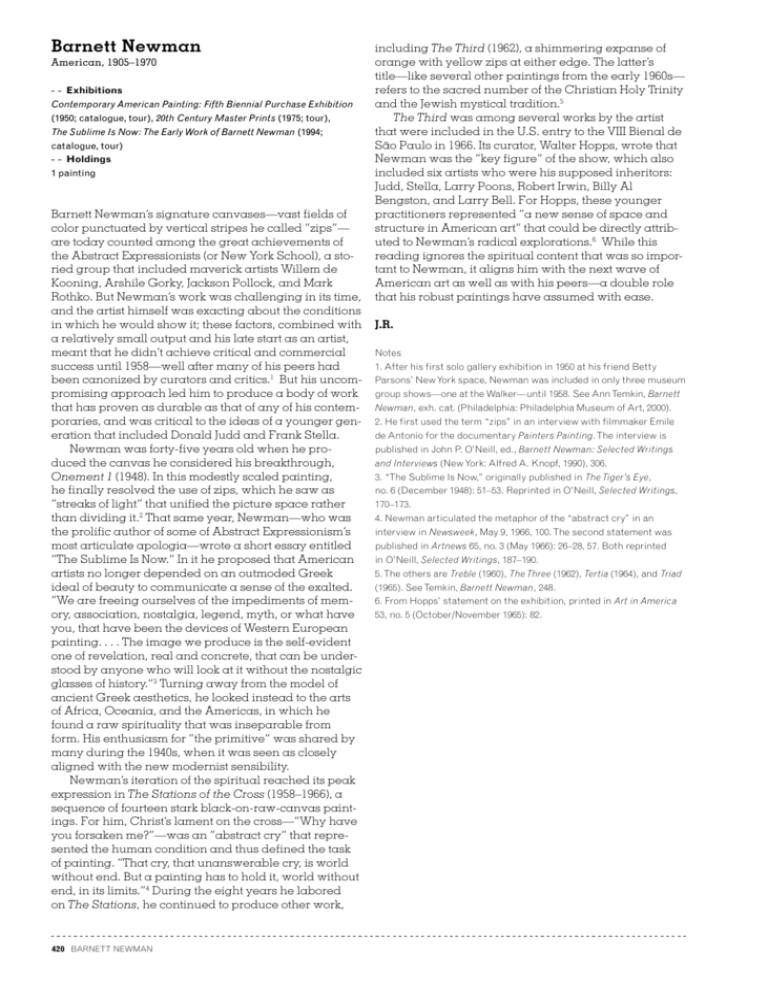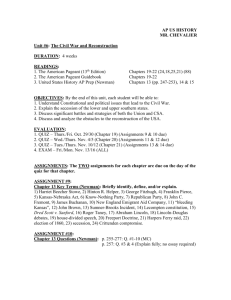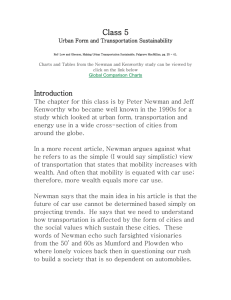
Barnett Newman
American, 1905–1970
Exhibitions
Contemporary American Painting: Fifth Biennial Purchase Exhibition
(1950; catalogue, tour), 20th Century Master Prints (1975; tour),
The Sublime Is Now: The Early Work of Barnett Newman (1994;
catalogue, tour)
Holdings
1 painting
Barnett Newman’s signature canvases—vast fields of
color punctuated by vertical stripes he called “zips”—
are today counted among the great achievements of
the Abstract Expressionists (or New York School), a storied group that included maverick artists Willem de
Kooning, Arshile Gorky, Jackson Pollock, and Mark
Rothko. But Newman’s work was challenging in its time,
and the artist himself was exacting about the conditions
in which he would show it; these factors, combined with
a relatively small output and his late start as an artist,
meant that he didn’t achieve critical and commercial
success until 1958—well after many of his peers had
been canonized by curators and critics.1 But his uncompromising approach led him to produce a body of work
that has proven as durable as that of any of his contemporaries, and was critical to the ideas of a younger generation that included Donald Judd and Frank Stella.
Newman was forty-five years old when he produced the canvas he considered his breakthrough,
Onement 1 (1948). In this modestly scaled painting,
he finally resolved the use of zips, which he saw as
“streaks of light” that unified the picture space rather
than dividing it.2 That same year, Newman—who was
the prolific author of some of Abstract Expressionism’s
most articulate apologia—wrote a short essay entitled
“The Sublime Is Now.” In it he proposed that American
artists no longer depended on an outmoded Greek
ideal of beauty to communicate a sense of the exalted.
“We are freeing ourselves of the impediments of memory, association, nostalgia, legend, myth, or what have
you, that have been the devices of Western European
painting. . . . The image we produce is the self-evident
one of revelation, real and concrete, that can be understood by anyone who will look at it without the nostalgic
glasses of history.”3 Turning away from the model of
ancient Greek aesthetics, he looked instead to the arts
of Africa, Oceania, and the Americas, in which he
found a raw spirituality that was inseparable from
form. His enthusiasm for “the primitive” was shared by
many during the 1940s, when it was seen as closely
aligned with the new modernist sensibility.
Newman’s iteration of the spiritual reached its peak
expression in The Stations of the Cross (1958–1966), a
sequence of fourteen stark black-on-raw-canvas paintings. For him, Christ’s lament on the cross—“Why have
you forsaken me?”—was an “abstract cry” that represented the human condition and thus defined the task
of painting. “That cry, that unanswerable cry, is world
without end. But a painting has to hold it, world without
end, in its limits.”4 During the eight years he labored
on The Stations, he continued to produce other work,
420 BARNETT NEWMAN
including The Third (1962), a shimmering expanse of
orange with yellow zips at either edge. The latter’s
title—like several other paintings from the early 1960s—
refers to the sacred number of the Christian Holy Trinity
and the Jewish mystical tradition.5
The Third was among several works by the artist
that were included in the U.S. entry to the VIII Bienal de
São Paulo in 1966. Its curator, Walter Hopps, wrote that
Newman was the “key figure” of the show, which also
included six artists who were his supposed inheritors:
Judd, Stella, Larry Poons, Robert Irwin, Billy Al
Bengston, and Larry Bell. For Hopps, these younger
practitioners represented “a new sense of space and
structure in American art” that could be directly attributed to Newman’s radical explorations.6 While this
reading ignores the spiritual content that was so important to Newman, it aligns him with the next wave of
American art as well as with his peers—a double role
that his robust paintings have assumed with ease.
J.R.
Notes
1. After his first solo gallery exhibition in 1950 at his friend Betty
Parsons’ New York space, Newman was included in only three museum
group shows—one at the Walker—until 1958. See Ann Temkin, Barnett
Newman, exh. cat. (Philadelphia: Philadelphia Museum of Art, 2000).
2. He first used the term “zips” in an interview with filmmaker Emile
de Antonio for the documentary Painters Painting. The interview is
published in John P. O’Neill, ed., Barnett Newman: Selected Writings
and Interviews (New York: Alfred A. Knopf, 1990), 306.
3. “The Sublime Is Now,” originally published in The Tiger’s Eye,
no. 6 (December 1948): 51–53. Reprinted in O’Neill, Selected Writings,
170–173.
4. Newman articulated the metaphor of the “abstract cry” in an
interview in Newsweek, May 9, 1966, 100. The second statement was
published in Artnews 65, no. 3 (May 1966): 26–28, 57. Both reprinted
in O’Neill, Selected Writings, 187–190.
5. The others are Treble (1960), The Three (1962), Tertia (1964), and Triad
(1965). See Temkin, Barnett Newman, 248.
6. From Hopps’ statement on the exhibition, printed in Art in America
53, no. 5 (October/November 1965): 82.
Barnett Newman The Third 1962 oil on canvas 101 1/2 x 120 1/4 in. (257.8 x 305.4 cm) Gift of Judy and Kenneth Dayton, 1978 1978.3
BARNETT NEWMAN 421
THIRD
Do what is right the voice from the left said.
I do not know what is right I said. The voice
Is a kind of light and comes always from the left.
Yes. Annunciation comes as a reading always from
Left to right—from where we stand.
I don’t know where to start I don’t think my face
in my hands is right Please don’t let us destroy
Your world no the world I know I know nothing I know I
can’t use you like this It feels better if I’m on
my knees If my eyes are pressed shut so I can see
the other things the tiniest ones which can still escape
us Am I human Please show me mercy no please show
a way If I look up all the possibility that you
might be there goes away I need to be curled up this
way my face pressed down my knees pulled up tight
I know there are other ways less protected more expressive of
surrender but here I can feel the whole crushing
emptiness on my back especially on my shoulders
I thought just now how that emptiness could be my wings
that you were maybe there laughing and that the room above
me here before dawn with its two windows black and this
bed pillow face pressed down hard on my hands how it, how all of it,
made up the wings There is a reason I
have to go fast I have to try to slip-in to some channel
I can feel the beginning of here in my pushed-down face right
where my face is pressed so sleep doesn’t go there
anymore and the mirror—well that is another way if you wish, if you
look in for a very long time—but here, I did it
again (here)(I write the open parenthesis, press my face,
try again, then lift, close)(then this clause to explain)
(to whom?)(always wanting to be forgiven)(not seen—
no, no this thing I am in the dark rolled up is not a thing
for an eye—it wants to be an eye—it sees at the end
of the dark its face is pressing-towards a line, not a
going-in line but a line that stops one, a wall—See
it is already being lost here, the
channel is filling in, these words—ah—these, these—
How I don’t want them to be the problem too there are
so many other obstacles, can’t these be just a part of
my body, look (put my head down again)(am
working in total dark)(maybe this will not be
legible)—cover my ears to go further—
maybe if I had begun otherwise, maybe if I had
been taught to believe in You, I needed evidence,
others seem not to need it, they do not seem to me
graced but yesterday when I asked Don he said yes he
was sure
everything was His plan so it was a lapse of faith
to worry, you will have noted I cannot say “Your
plan” and now, as if dawn were creeping in, the
feeling of the reader is coming in, the one towards which
this tilts like the plant I watched a
long time yesterday the head of and then the stem itself,
long, to see if it turned towards the light as the light arrived,
I would say it did, very slightly, and I
could not see it
422 BARNETT NEWMAN
though I never lifted my gaze and tried very hard to blink only
when physically impossible not to, and yes, and yes, in the end it
was in a different direction, I had marked where we started
so I knew for sure, although of course I know nothing, I could
begin this story anywhere, maybe I will open my
eyes now, although I have gotten nowhere and will
find myself
still just here, in the middle of my exactly given years, on
my knees naked in my room before dawn, the pillow
wet of course but what of it, nothing nothing comes of it,
they are all blind it seems to me out there where the
garbage truck will begin any second now, but I am supposed
to love, and also I must not care what others think, I
must be sure of myself—the knotted emissary of
wholesale murder—I can feel the whitening reefs which
I have only read about if that means anything (yes, no) under there where
they are, I put them in the space with the far wall, I see
the waters filtering through them all, the pH is wrong, the
terrible bleaching is occurring, the temperature—what
is a few degrees—how fine are we supposed
to be, I am your instrument if you would only use me, a
degree a fraction of a degree in the beautiful thin
water, flowing through, finding as it is meant to every
hollow and going in, carrying its devastation, but it looks so
simple, and a blue I have never seen, with light still in its
body, as light is in mine here I believe, technically,
yes light from a chemical point of view an
analysis would reveal, something which partakes of the same photons
which are in all matter, in this pillow, in the paint on the
wall which if I open my eyes will be five inches from my
face, the coral reefs having caverns I try to go in, I
can make myself very small is that a gift from you,
I think it might be one of the great gifts, that I can make
myself very small and go in, in from this room down into the
fibrous crenellations of the reef, which if you look close are formed
by one node clipping onto an other and then
the rounding-up as the damage occurs as the weight is lost. Now the coral
is in with the
garbage trucks, pipeknock kicks in, it is beginning
again—when I open my eyes I see two white lines,
vertical, incandescent, I will keep all
knowledge away I think, I try to think, I will keep
the knowing away the lines seem to come out of nowhere
they do not descend nor do they rise but
just gleam side by side in the small piece of
glance my two eyes hold in their close-up
vision. There is a flood. There are these two lines.
Then the sun moves up a notch though still in the invisible, and I see it is the 12 ounce glass, its body
illumined twice, white strokes where the very first
light has entered, here, I look again, it gleams,
it seems to gleam, it is the empty glass.
Jorie Graham
BARNETT NEWMAN 423
Bits & Pieces Put Together to Present a Semblance
of a Whole: Walker Art Center Collections
Joan Rothfuss and Elizabeth Carpenter
Bits & Pieces Put Together to Present a Semblance
of a Whole: Walker Art Center Collections is published
on the occasion of the opening of the newly expanded
Walker Art Center, April 2005.
Major support for Walker Art Center programs is
provided by the Minnesota State Arts Board through
an appropriation by the Minnesota State Legislature,
The Wallace Foundation, the Doris Duke Charitable
Foundation through the Doris Duke Fund for Jazz
and Dance and the Doris Duke Performing Arts
Endowment Fund, The Bush Foundation, Target,
General Mills Foundation, Best Buy Co., Inc., The
McKnight Foundation, Coldwell Banker Burnet,
the Institute of Museum and Library Services, the
National Endowment for the Arts, American Express
Philanthropic Program, The Regis Foundation, The
Cargill Foundation, 3M, Star Tribune Foundation,
U.S. Bank, The Andrew W. Mellon Foundation, and
the members of the Walker Art Center.
Library of Congress Cataloging-in-Publication Data
Walker Art Center
Bits & pieces put together to present a semblance of a
whole : Walker Art
Center collections.-- 1st ed.
p. cm.
Includes index.
ISBN 0-935640-78-9 (hardcover : alk. paper)
1. Walker Art Center--Catalogs. 2.
Arts--Minnesota--Minneapolis--Catalogs. 3. Walker Art
Center--History. I.
Title: Bits and pieces put together to present a
semblance of a whole. II.
Title: Walker Art Center collections. III. Title.
N583.A53 2005
709’.04’0074776579--dc22
2004031088
First Edition
© 2005 Walker Art Center
All rights reserved under pan-American copyright conventions. No part of this book may be reproduced or
utilized in any form or by any means—electronic or mechanical, including photocopying, recording, or by any
information storage-and-retrieval system—without permission in writing from the Walker Art Center. Inquiries
should be addressed to: Publications Manager, Walker
Art Center, 1750 Hennepin Avenue, Minneapolis,
Minnesota 55403.
Available through D.A.P./Distributed Art Publishers
155 Sixth Avenue, New York, NY 10013
WALKER ART CENTER COLLECTIONS
Every reasonable attempt has been made to identify
owners of copyright. Errors or omissions will be
corrected in subsequent editions.
Wayne Koestenbaum, “Jackie and Repetition,” from
Jackie Under My Skin: Interpreting an Icon (New York:
Farrar, Straus and Giroux, 1995), © by permission of
the author.
Publications Manager
Lisa Middag
Editors
Pamela Johnson, Kathleen McLean
Designers
Andrew Blauvelt, Chad Kloepfer
Production Specialist
Greg Beckel
Printed and bound in Belgium by Die Keure.
Cover art
Lawrence Weiner






